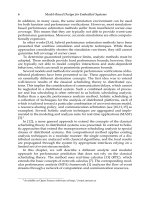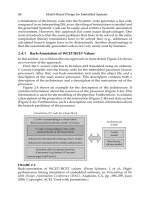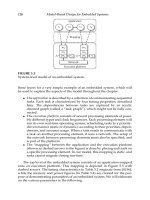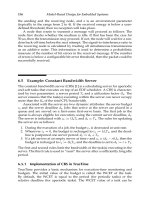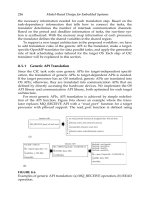Model-Based Design for Embedded Systems- P15 pot
Bạn đang xem bản rút gọn của tài liệu. Xem và tải ngay bản đầy đủ của tài liệu tại đây (508.73 KB, 10 trang )
Nicolescu/Model-Based Design for Embedded Systems 67842_C004 Finals Page 106 2009-9-30
106 Model-Based Design for Embedded Systems
Listing 4.5 Function to determine clock rate of the x clock of a given task.
1 int [0,1] isRunning() { return ( buffer[resource ()]. element[0] == id? 1 : 0);}
Each task uses two clock variables called time and x, where time repre-
sents the time since the beginning of the current period, and x represents
how long the task has executed in the current period. The variable x is a local
variable whereas time is global, and, thus, indexed by the task id. As we are
using stopwatch automata, note that the progress rate of x is set to zero in
all but the Ready location. In Ready, the rate determines whether the task
is currently executing on the given resource. This is checked using the local
function isRunning() defined in Listing 4.5.
On the other hand, time is always running and is reset at every period, so
that when time exceeds the deadline, the task can move to Error.
Upon entering Ready, the task updates the variable ready_task with the
task id to indicate which task has signaled to the given resource. The resource
utilizes this id when inserting the task in the queue for execution. We return
to this in Section 4.4.4.
To allow for problem-specific requirements, such as individual task-
constraints, the task template includes the following three functions:
new_period, dependencies_met,andcompleted. These functions can be used
for a variety of problem-specific purposes, the most obvious of which is
the task graph dependency definition. How to model task graphs is illus-
trated as follows: new_period is executed on the edges leading to Waiting
and used for updating data structures, indicating that the task is begin-
ning a new period; dependencies_met is tested in the guard leading from
WaitingDependency to Ready;andcompleted is executed on the edge
exiting Ready toward either Done location.
4.4.3.1 Modeling Task Graphs
To model task graphs using the customizable functions described above, we
first need a global data structure to hold the task graph itself. In Listing 4.6,
the task graph is modeled using a square Boolean dependency matrix where
entry (i, j) dictates whether task i depends on task j. In the sample, we have
four tasks, t
0
, ,t
3
, where task 0 depends on task 1, which depends on task
2, which depends on task 3.
Furthermore, we have a Boolean array variable complete that deter-
mines whether a given task has finished execution. It is the responsibility
of every function to reset the corresponding entry of this array in every
period. In Listing 4.6, this is handled in the local task function, new_period.
The value of complete is set to true when a task finishes execution in
the completed function call. Finally, tasks cannot enter the Ready location
from WaitingDependency until the function dependencies_met evaluates
to true. This function simply iterates the corresponding row of the task graph
Nicolescu/Model-Based Design for Embedded Systems 67842_C004 Finals Page 107 2009-9-30
Model-Based Framework for Schedulability Analysis Using UPPAAL 4.1 107
Listing 4.6 Modelling task graphs.
1 //Global declaration
2 const bool TaskGraph[Tasks][Tasks] = {
3 {0,1,0,0},
4 {0,0,1,0},
5 {0,0,0,1},
6 {0,0,0,0}
7 };
8 bool complete[Tasks];
9
10
//Task local declaration
11 void new_period() {
12 complete[id] = false ;
13 }
14
15
bool dependencies_met() {
16 return forall ( j : t_id ) TaskGraph[id][j] imply complete[j];
17 }
18
19
void completed() {
20 complete[id] = true;
21 }
matrix and asserts that if the task depends on another task, the entry of the
complete array for that task must be true.
With these steps, we have successfully modeled a task graph using our
framework.
Note that extra care must be taken about specifying task periods when
using task dependencies, as the meaning of a dependency can become
unclear if the task periods are out of sync. The above handling of task graphs
reset the complete variable on every new period, which is safe if dependent
tasks have the same period, but not necessarily so if the tasks do not. Thus, a
good rule of thumb is to only specify task dependencies between tasks that
have identical periods and no nondeterminism on periods.
4.4.4 Resource Template
The resource template described in this section is identical for both pre-
emptive and nonpreemptive schedulers. The resource model is depicted
in Figure 4.5, and the main difference between this model and the idea
described in Section 4.4.1 is that the resource template does not include a
clock. All timings are handled solely by the tasks.
A resource takes three input parameters that are the resource id (id),
a Boolean preempt to indicate whether the resource is preemptive, and a
scheduling policy of integer type policy_t.
Nicolescu/Model-Based Design for Embedded Systems 67842_C004 Finals Page 108 2009-9-30
108 Model-Based Design for Embedded Systems
ready [id]?
ready [id]?
finished[front ()]?
Insert_task [policy]!
Inserted?
empty ()
!empty ()
Idle
InUse
removetTask ()
empty ()
!empty ()
C
C
C
Insert_at (0,ready_task,id)
setParams (ready_task,id,preemptive)
FIGURE 4.5
Resource—takes argument’s id of type r_id, preempt of type bool, and policy
of type policy_t.
Listing 4.7 Insert a task in the buffer of a resource at a given position.
1 void insert_at ( int [0,Tasks] pos, t_id tid , r_id rid ) {
2 int i;
3 for( i = buffer [rid ].length; i > pos; i−−){
4 buffer [rid ].element[i] = buffer [ rid ]. element[i−1];
5 }
6 buffer[ rid ]. element[pos] = tid ;
7 buffer[ rid ]. length++;
8 }
The template has the two main locations Idle and InUse to indicate
the status of the resource. Idle resources are waiting for tasks to signal that
they are ready via the “ready” channel of the resource. Upon receiving such a
signal from either Idle or InUse, the resource will place the task at the front
of its buffer if the buffer is empty. Emptiness is tested with the local function
empty that reads the length of the respective buffer. Inserting a task in the
buffer is done via the global insert_at function defined in Listing 4.7, and
takes a position, a task id, and a resource id as an argument. The inserting
procedure moves all tasks in the buffer from the insert position one position
back (lines 3–5), and then inserts the task at the desired position, and, finally,
updates the length of the buffer.
In case there is at least one element in the resource buffer already, the
scheduling principle determines where to place the ready task in the buffer.
Each scheduling principle is a separate model that is activated by synchro-
nization over the channel “insert_task” indexed which the scheduling policy.
The scheduling policy needs information about the task, the resource, and
whether the resource is preemptive, in order to make the decision of where
to place the incoming task in the buffer. This information is transferred via
Nicolescu/Model-Based Design for Embedded Systems 67842_C004 Finals Page 109 2009-9-30
Model-Based Framework for Schedulability Analysis Using UPPAAL 4.1 109
Listing 4.8 Remove the front task from the resource buffer of the given
resource.
1 void removeTask() {
2 int i = 0;
3 buffer[id ]. length−−;
4 do {
5 buffer [id]. element[i] = buffer [id ].element[i+1];
6 i++;
7 } while ( i < buffer [id ]. length );
8 buffer[id ].element[buffer[id ]. length] = 0;
9 }
the setParams function that copies this information to meta-variables, which
can be read by the scheduler. We return to this in Section 4.4.5.
The resource remains in the committed location waiting for the signal
“inserted” indicating that the task has been inserted in the resource buffer
according to the scheduling policy. The waiting location is committed to
guarantee that all task-insertion processes should take place as atomic oper-
ations. If a scheduling policy does not adhere to this constraint, the system
deadlocks.
Upon inserting the task in the buffer according to the scheduling pol-
icy, the resource moves to the InUse location. The resource remains there
until either the running task signals the completion of execution through
“finished” or another task signals that it is ready. In the latter case, the
resource repeats the insertion process described above. In the former case,
the resource removes the task from its buffer with the local function remove-
Task (see Listing 4.8). Depending on whether the resource buffer is empty,
the resource returns to either Idle or InUse.
The above resource template can be used to model different types of
resources and supports an easy manner to implement specialized schedul-
ing policies with minimal overhead. In the following section, we describe
how to model three types of scheduling policies in our framework.
4.4.5 Scheduling Policies
In this section, we describe models for three types of scheduling policies:
FIFO, FPS, and EDF. Common to all scheduling principles in our framework
is that the scheduling policy is only called if there is at least one element in
the resource buffer already. This precondition is guaranteed by the resource
template by not calling the scheduling policy when the resource buffer is
empty and instead inserting the ready task at the front of the buffer.
The parameters transferred to the scheduling policies via the setParams
function are stored in a struct meta-variable called param. This way, the
Nicolescu/Model-Based Design for Embedded Systems 67842_C004 Finals Page 110 2009-9-30
110 Model-Based Design for Embedded Systems
insert_task [FIFO]?
insert_at (buffer[param.resource].length,
param.task,
param.resource)
inserted!
C
FIGURE 4.6
The FIFO scheduling policy.
parameters are accessible to the scheduling policies without increasing
the state space, as meta-variables are ignored for state comparison. The
parameters are availble to the policy via param.task, param.prempt,and
param.resource, respectively.
4.4.5.1 First-In First-Out (FIFO)
FIFO is the simplest scheduling policy as tasks are simply put into the
resource buffer in the order in which they arrive. This implies that FIFO
scheduling disregards whether the resource is preemptive or not. The model
for the FIFO policy is depicted in Figure 4.6, where insertion of the task is
handled on the edge synchronizing on “insert_task.”
4.4.5.2 Fixed Priority
The fixed priority scheduling policy (FPS) model is similar to that of FIFO
in structure, except that the task insertion is handled by the function call
insert_task_in_buffer (Listing 4.9) instead of a call insert_task. The function
iterates (lines 6–8) through the resource buffer and compares the priority of
the incoming task with the tasks in the buffer, and sets a local variable place
such that the incoming task has a lower priority than all tasks in front of
it and a higher priority than all tasks behind it. In case the incoming task
has the lowest priority of all tasks in the buffer, the iteration is terminated
by reaching the end of the buffer and inserts the task here. Obviously, this
method requires the buffer to be sorted. However, as the method is used for
all insertions, except the first, the buffer remains sorted. When the place of
insertion has been established, the task is inserted using the insert_at function
call (line 9).
Note in Listing 4.9 that preemption is handled in line 4 where the first
assumed place of the incoming task is either the first buffer entry, in case of
preemption, or the second index, in case of no preemption. This code utilizes
the precondition that the buffer has at least one element when the function is
called.
Nicolescu/Model-Based Design for Embedded Systems 67842_C004 Finals Page 111 2009-9-30
Model-Based Framework for Schedulability Analysis Using UPPAAL 4.1 111
Listing 4.9 Function for task insertion according to FPS.
1 void insert_task_in_buffer () {
2 t_id t = param.task;
3 r_id r = param.resource;
4 int place = (param.preempt ? 0 : 1);
5 int i;
6 while(place<buffer[r ]. length &&
7 task[ buffer [r ].element[place]].pri>=task[t ]. pri ){
8 place++;
9 }
10 insert_at (place,t ,r );
11 }
4.4.5.3 Earliest Deadline First
The two scheduling policies above do not, in principle, need separate models,
as task insertion can be handled by a simple function call. However, because
of the U
PPAAL modeling language constraints, scheduling policies such as the
EDF cannot be handled in our framework as a simple function call, but need
to implement the insertion as a model. The problem lies in that to determine
how far a task i is from its deadline, we need to look at the difference between
task[i].deadline and time[i].U
PPAAL does not allow such a comparison in func-
tion calls as it requires operations on the clock zone data structure. However,
U
PPAAL does allow such comparisons in the guard expression, and, thus, in
order to find the position of an incoming task in a resource buffer we need
to iterate through the buffer as model transitions comparing deadlines using
guards.
In order to compare whether an incoming task i has an earlier deadline
than a buffered task j, we need to check the following:
task[i].deadline-time[i] < task[j].deadline - time[j]
⇔ time[i] -task[i].deadline > time[j] - task[j].deadline
Note that U
PPAAL only allows subtraction of constants from clock values and
not the reverse, hence the rewriting of the expression.
For convenience, we introduce a number of local variables and functions
for the EDF model, as defined in Listing 4.10. These are variables to hold the
parameters that are transferred from the resource, a function readParameters
to set the values of the local variables, and a function resetVars to reset the
variables after task insertion to minimize the search space.
Figure 4.7 depicts the model for the EDF task-insertion. Initially, the
model reads the parameters and sets the initial assumed place variable of
insertion according to whether or note the calling resource is preemptive
(same as for the FPS). Now, the deadline of the incoming task is compared to
the deadline of the task at place.Ifplace is either past the last element in the
buffer or the incoming task has an earlier deadline than the task at place,the
Nicolescu/Model-Based Design for Embedded Systems 67842_C004 Finals Page 112 2009-9-30
112 Model-Based Design for Embedded Systems
Listing 4.10 Local variables and function for the EDF scheduling policy.
1 int [0,Tasks] place;
2 t_id tid ;
3 r_id rid ;
4 bool preempt;
5 void readParameters() {
6 tid = param.task; rid = param.resource; preempt = param.preempt;
7 }
8 void resetVars () { place = tid = rid = 0; }
insert_task[EDF]?
inserted!
readParameters(),
place = (preempt ? 0 : 1)
place == buffer[rid].length ||
time[tid]−task[tid].deadline>
time[buffer[rid].element[place]]− task[buffer[rid].element[place]].deadline
place < buffer(rid).length &&
time[tid]–task[tid].deadline <=
time[buffer[rid].element[place]]− task[buffer[rid].element[place]].deadline
insert_at(place,tid,rid)
resetVars( )
Place++
C
C
FIGURE 4.7
The EDF scheduling policy.
incoming task is inserted at this place in the buffer with a call to the global
function insert_at. Otherwise, place is incremented and the deadline check is
performed again. Note that this is nothing more than a model implementa-
tion of a regular while-loop as used for the FPS.
This concludes our model framework for schedulability analysis, and in
the following section we proceed by showing how to instantiate the frame-
work and formulate schedulability queries.
4.5 Framework Instantiation
In this section, we focus on instantiating our scheduling framework for stan-
dard scheduling problems. Instantiation requires data entry in the global
declaration as well as in the system definition. The data needed in the global
declaration is shown in Listing 4.11.
Nicolescu/Model-Based Design for Embedded Systems 67842_C004 Finals Page 113 2009-9-30
Model-Based Framework for Schedulability Analysis Using UPPAAL 4.1 113
Listing 4.11 Local variables and function for the EDF scheduling policy.
1 const bool Periodic = ; // Periodic Scheduling?
2 const int Tasks = ; // Number of tasks
3 const int Procs = ; // Number of resources
4 const int MaxTime = ; // Maximum time constant
5 const task_t task[Tasks] = { };
Listing 4.12 Local variables and function for the EDF scheduling policy.
1 P1 = Resource(0, true / false , EDF/FPS/FIFO);
2 P2 = Resource(1, true / false , EDF/FPS/FIFO);
3
4 system Task, P1, P2, , Policy_EDF, Policy_FPS, Policy_FIFO;
For a particular scheduling problem, the user needs to specify whether it
is a periodic scheduling problem, how many tasks and resources there are,
the maximum time constant for all tasks,
∗
and the task attributes.
When defining the system, the user needs to specify the properties of the
different resources, that is, preemption and scheduling policy.
In Listing 4.12, we show a sample system declaration with a number of
resources
(
P
1
, P
2
,
)
. When declaring the actual system with the system key-
word, all defined resources should be included with a single copy of each
scheduling policy used. Note that all tasks are included with the single Task
instantiation. This is because the parameter spaces of tasks are bound by the
t_id type, so if no parameter is used, U
PPAAL instantiates a copy of a task for
every possible id.
4.5.1 Schedulability Query
For any given scheduling problem, the schedulability of checking whether all
tasks always meet their respective deadlines can be stated as in Section 4.4.1:
A[] forall ( i : t_id ) not Task(i).Error
In other words, “Does it hold for all paths that no task is ever in the
Error location?” Note that U
PPAAL using stopwatches creates an over-
approximation of the state space, meaning that if the above query is satisfi-
able, it is guaranteed that the system is schedulable under all circumstances.
However, if the query is not satisfiable, this means that a counterexample has
been established in the overapproximation. The system may still be schedu-
lable however, since the counterexample is not necessarily a feasible run of
the original system.
∗
Used for UPPAAL state footprint reduction.
Nicolescu/Model-Based Design for Embedded Systems 67842_C004 Finals Page 114 2009-9-30
114 Model-Based Design for Embedded Systems
4.5.2 Example Framework Instantiation
In this section, we provide a sample periodic schedulability problem and
illustrate how to instantiate our framework for this problem. Part of the
schedulability problem is depicted in Figure 4.8a. It is a simple system with
four tasks, T = t
0
, , t
3
, and two resources, P
0
,andP
1
and with task depen-
dencies given as a task graph. As indicated by dashed lines in Figure 4.8,
tasks t
0
and t
1
are assigned to P
0
and tasks t
2
and t
3
are assigned to P
1
.
Note that task t
3
depends on task t
0
, but the tasks are assigned to different
resources. This is a common scheduling situation, and, usually, requires the
communication of data between resources using a transport medium such as
a data bus. The communication of data takes time, but does not block either
of the resources. In our framework, such a scenario can be modeled as illus-
trated in Figure 4.8, introducing a new task t
4
that requires a new resource,
Bus.Thetaskt
4
is inserted into the task graph such that t
4
depends on t
0
and
t
3
depends on t
4
. We assume for the reasons explained in Section 4.4.3.1 that
all tasks have fixed and identical periods. Thus, the attributes of t
4
should be
set such that
•
INITIAL_OFFSET(t
4
)=INITIAL_OFFSET(t
0
).
•
BCET(t
4
): Specific to the bus.
•
WCET(t
4
): Specific to the bus.
•
MIN_PERIOD(t
4
)=MIN_PERIOD(t
0
). Given our assumption about identical
periods, the minimum and maximum periods are equal and the same
for all tasks.
•
MAX_PERIOD(t
4
)=MIN_PERIOD(t
4
).
•
OFFSET(t
4
) = 0. Offset not needed as the task release is determined by the
completion of t
0
.
•
DEADLINE(t
4
)=MIN_PERIOD(t
4
). Could be tightened with respect to the
deadline of t
3
and XCET(t
4
).
•
PRIORITY(t
4
) = 0. Irrelevant, as the bus is a FIFO resource.
t
0
t
1
(a) (b)
P
1
t
3
t
2
t
0
t
1
t
4
P
1
t
3
t
2
Bus
P
0
P
0
FIGURE 4.8
Sample schedulability problem. (a) Task graph with interdependent tasks
across resources and (b) how to solve this problem by introducing a new
task and a bus resource.
Nicolescu/Model-Based Design for Embedded Systems 67842_C004 Finals Page 115 2009-9-30
Model-Based Framework for Schedulability Analysis Using UPPAAL 4.1 115
Listing 4.13 Modelling task graphs.
1 //Global Declaration
2 const bool Periodic = true;
3 const int MaxTime = 20;
4 const int Tasks = 5; // Number of tasks
5 const int Procs = 3; // Number of resources
6
7
const task_t task[Tasks] = {
8 {0,20,20,0,20,4,7,0,1},
9 {0,20,20,1,20,8,12,0,1},
10 {0,20,20,0,20,10,12,1,1},
11 {0,20,20,1,20,6,7,1,1},
12 {0,20,20,1,20,5,5,2,1}
13 };
14
15
const bool Depend[Tasks][Tasks] = { // Task graph
16 {0,0,0,0,0},
17 {1,0,0,0,0},
18 {0,0,0,0,0},
19 {0,0,1,0,1},
20 {1,0,0,0,0}
21 };
22
23
//System Declaration
24 P0 = Resource(0,true,FPS);
25 P1 = Resource(1,true,FPS);
26 Bus = Resource(2,false,FIFO);
27
28
system Task, P0, P1, Bus, Policy_FPS, Policy_FIFO;
The “bus” resource will be modeled as a nonpreemptive FIFO resource to
mimic the behavior of a data bus. Assuming some specific best-case and
worst-case execution times, periods, deadlines, etc., the schedulability prob-
lem described above can be instantiated as shown in Listing 4.13.
Note in Listing 4.13 that the three tasks that depend on other tasks have
been given an offset of 1. This is for convenience, as it is the responsi-
bility of individual tasks to reset their own entry in complete. Upon the
start of a new period without the offset, task t
1
could signal ready to the
resource while reading an old value of complete for task t
0
before t
0
resets
the value. Another way to handle this when all dependent tasks have the
same fixed periods would be to let any task reset all values to complete
when starting a new period. However, there is no general good way of
handling this problem and it is left to the modeler to prevent unwanted
situations.

